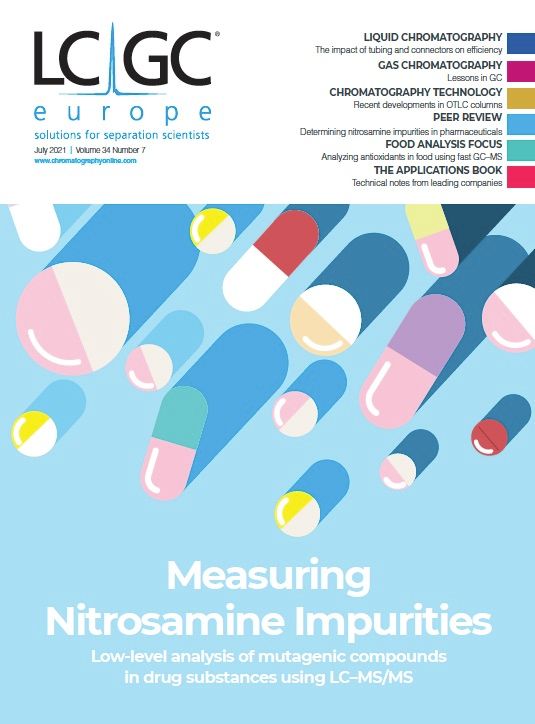Hard-Won Lessons in GC
ChromTalks provided a new approach to a scientific symposium: Get the speakers to talk about mistakes and hard lessons learned that ultimately led to some of their successes. There were four days of presentations, each including industrial and academic speakers and vendor presentations. The four days encompassed sample preparation, liquid chromatography (LC), mass spectrometry (MS), and gas chromatography (GC).
The full presentations are available online at https://view.ceros.com/mjh-life-sciences/lcgc-ca-symposium/p/1 or point your browser to www.chromatographyonline.com and click the link for ChromTalks or search “ChromTalks”.
The sample preparation sessions focused largely on techniques that are commonly used with GC, especially QuEChERS (Quick, Easy, Cheap, Effective, Rugged, and Safe), presented by Dr. Steven Lehotay, of the United States Department of Agriculture, one of the inventors of the QuEChERS approach, and solid-phase microextraction (SPME), presented by its inventor, Professor Janusz Pawliszyn of the University of Waterloo (Ontario, Canada).
Mass spectrometry was discussed by Koen Sandra of the Research Institute for Chromatography in Belgium, Kevin Schug of the University of Texas-Arlington (USA), and Susan Richardson of the University of South Carolina (USA).
All three speakers spoke of successes, failures, and strange stories as they worked to figure out two instrumental techniques at once: chromatography and mass spectrometry.
The gas chromatography session was led off by Dr. John Hinshaw, the former editor of this column for nearly 25 years. John’s chromatography career spans over 40 years with stints at Varian, PerkinElmer, and currently with Serveron. John spoke of experiences and incidents over his career that many scientists can relate to. In a broad sense, John shared the following key points for experimenting, optimizing, and troubleshooting: focus on safety first, not results; be observant and ask the right questions (What? When? Who?); get to root causes (How? Why? Test!); and make appropriate changes (desired, possible, and practical). Lesson #1: In practical troubleshooting or optimizing, the result may be cost-effective, time-bound, or high performanceÑyou get two out of three, and, perhaps most importantly, only change one thing at a time.
John discussed the early computers and electronics that provide the foundations for today’s modern instruments and data systems, discussed in some recent “GC Connections” instalments (1). These included starting on a plug-board manual computer (have you ever heard of one of these?), time shared BASIC (Beginners All-purpose Symbolic Instruction Code) programming in the late 1960s, and working with punch card computing. The original version of the famous DryLab chromatography optimization software was written in BASIC. If a punch card had one error (or even a typo), the program would fail. Additionally, other adventures were discussed, including building a pirate AM radio station that was subsequently shut down. Lesson #2: Understand how your electronics and data systems work, and beware of federal and governmental regulations.
John started working for Varian as fused-silica capillary columns were becoming available. They used static coating in a fish tank (complete with fish!) to apply the stationary phase to the inside of the capillary tubing. The big challenge with making early columns was drawing out the fused silica with traditional glass coating machines that did not work well, so they changed to purchasing the fused silica. Early gas chromatographs, especially when used with capillary GC, had many interesting engineering challenges. John related a troubleshooting problem that the baseline on a flame ionization detector (FID) would elevate at seemingly random intervals. They eventually solved the problem: Opening the laboratory door caused pressure changes in the laboratory that caused flow changes in the detector, so they re-engineered the detector to eliminate the flow problem. I encountered a similar problem some years later, from accidentally using a contaminated
air supply. Lesson #3: Troubleshooting is a perfect example of John’s first admonitions: Ask the right questions, get to the root causes, and make practical changes, one at a time.
Most of John’s career was spent at PerkinElmer as an applications manager, a principal scientist in instrument and applications development, and later as a GC engineering manager. He described development of a quadrupole GC–MS system with software development in California, product management in Connecticut, development of the quadrupoles in Scotland, and the vacuum system in Germany. Multidisciplinary teams at multiple sites for the development of new products were somewhat unusual then, but are the norm today. Lesson #4: Get as much multidisciplinary training and experience as you can.
Dr. Jaap de Zeeuw of Restek has been making and working with capillary columns for over 40 years, and he shared perspectives and stories from his work as a long-time column maker. He spoke about practical experiences with capillary columns, how they have evolved, and how to extend their application and lifetime. He provided true inside stories about how the chemistry behind stationary-phase coating and bonding has evolved significantly in the four decades since invention of the fused-silica capillary columns commonly in use today.
Jaap discussed how we came to use fused-silica tubing, how fused-silica columns are drawn and made, and why they have become so popular. Prior to the introduction of fused silica in 1979, stainless steel and glass were used, and, later, aluminium. Glass is not user‑friendly and is fragile, although it is very stable. Aluminium seems promising, but coating is difficult, special connectors are needed, and aluminium is not robust for aggressive temperature programming. Deactivated stainless steel can be used, but is difficult to work with, and the thermal mass is higher. Fused silica solves most of these problems and can be run up to about 360 °C due to the polyimide coating on the outside of the column. Fused-silica columns can break if scratched by accident. Lesson #5: Long‑term operation of fused-silica columns at high temperatures can cause the polyimide coating to degrade and reduce column lifetime. Handle columns with care.
In the past, most stationary phases were made from industrial polymers and were very “dirty”. Today, major column manufacturers have in‑house polymer laboratories that produce very “clean” materials. This is one reason that the temperature stability of capillary columns has improved greatly over the years. Today, there are at least a dozen polysiloxane‑based stationary phases in use. Over time, however, even the newest stationary phases will degrade with temperature, so stabilizing groups and cross‑linking or cross-bonding are used to make the polymer chains more rigid. Lesson #6: Stabilized and cross-linked columns have better temperature stability, but they may not have the same selectivity as their non-stabilized equivalents. They are different polymers.
Coating columns is a “special art”. There are many techniques that can be used to coat a column, but the most important idea is that the coating must be homogeneous. Any distortions in the coating thickness will cause a loss of separation efficiency. Deactivation and phase stability are among the most important developments in stationary phases over the last 30 years. Columns must be inert, with deactivation of the fused silica in a manner which prevents formation of reactive silanol groups (is this sounding familiar, liquid chromatography folks?) with organic reagents, or by covering the surface with a polymer. However, deactivation can alter the retention and selectivity of the stationary phase. Lesson #7: Deactivation chemistry for the column must lead to minimal retention.
Yes, you still need to condition columns before use. Columns should be heated to the maximum temperature for at least 12 h. This is also a test to ensure that the column deactivation can withstand the upper temperature limit of the column. Exposing the column in the inlet can also cause degradation. This heated portion of the column will be exposed to a small amount of air every time a sample is injected. This air eventually results in column degradation. In addition, the liner will hold high-boiling contaminants that can eventually evaporate into the column and cause degradation. Derivatization reagents are often highly reactive, and they can also attack the column. It is possible for an initially inert column to lose performance quickly. Lesson #8: Keep the system and samples clean, condition the column, trim the column on a regular basis, and use the lowest possible temperature.
Jaap also shared insights about column bleed: Lesson #9: Bleed can be good. Bleed products can deactivate transfer lines, couplings, and ion sources. He described a simple experiment that showed this idea dramatically. High‑bleed columns can often show more inertness than low-bleed columns. He also described “priming” techniques where mixtures are pre-injected onto a column prior to analytical runs to “protect” the column from the analytes, or the analytes from the columns. In my own experience, we used to do this for an anabolic steroid method. Lesson #10: “Analyte protectants” can be used to prepare the column for highly reactive analytes such as pesticides (2).
Finally, I closed the session as “tail-end Charlie” for the academic and industrial speakers, and felt like a kid in this room with just over 30 years’ experience as a gas chromatographer. About 25 years ago, as a much younger chromatographer, I predicted that mass spectrometry would become the only major detector for GC, because it can be both universal and selective, and was becoming easier to use. Also, gas chromatographers love to use GC–MS with capillary GC due to simple interfacing: The capillary column is inserted directly into the ionization source.
Based on my (incorrect) prediction from 25 years ago, my title in the ChromTalks was “Should MS be the only detector for GC?” A simple look at the table of contents of a recently published comprehensive book on GC, or of my own basic text, should tell us the answer (3,4). The Poole text has five separate chapters on detectors and mine has two. New developments in detectors, such as vacuum ultraviolet (VUV) and catalytic reactors for the FID, are strong and ongoing. Lesson # 11: Classical GC detectors, including mass spectrometry, are alive and well.
Using examples and lessons from my own experiences, I discussed how a scientific career includes many (often overlapping) career arcs, and many people. When starting a project, I, too, have often asked the questions that John presented at the beginning of the symposium: What? When? Who? I was a very early adopter of SPME with GC–MS, but looked to work on projects that had not already been taken, so my students and I worked on SPME of drugs. Figuring out how to derivatize drugs extracted into an SPME fibre took over a year of failures, and destroyed fibres (with a 1995 list price of over $100 each) (5). It is a good thing that chromatographers are a community, and the vendor was willing to provide them for free. We were ultimately successful, and there have been hundreds of related papers by many authors since. Lesson #12: Every experiment, even the ones that “don’t work”, teaches us a lesson, and brings us closer to solving the problem.
Conclusion
The first ChromTalks online symposium in May 2021 was highly successful and informative. The biggest challenge we face when searching the literature and reading references is that, most often, the best and final results are presented, but not the inside stories, missteps, mistakes, and difficulties that led to the successful work. My own first paper on SPME of drugs was a short communication that was the result of about a year of failures and almost giving up. John concluded his presentation by reminding us to “never stop learning and innovating”. Jaap reminded us that we can only take advantage of the high inertness and excellent separation chemistry of today’s capillary columns if we also pay close attention to sample preparation and overall system cleanliness. My own closing remarks were a reminder to remember that chromatographers, whether just beginning or with years of experience, are a community of scientists solving difficult problems together.
Finally, I offer a “shout out” to the four sponsors of the GC session: relative newcomers Lucidity, the makers of miniature GC systems; Activated Research, who provide a catalytic reactor upgrade for FIDs and a low-cost comprehensive two‑dimensional gas chromatography (GC×GC) solution; long-time vendors LECO, the makers of GC×GC and GC×GC–MS systems as part of a broader product range; and PerkinElmer, one of the original players in GC and home to Marcel Golay, inventor of the capillary column. All four of these vendors also provided excellent presentations with useful and practical advice. I hope that we will be able to come together again soon as teachers, users, vendors, and colleagues, in-person, to share our successes—and our mistakes and failures.
ChromTalks Presentations On Demand

Additional information on ChromTalks, including access to all presentations on-demand, is available by scanning this QR code.
References
- N.H. Snow, LCGC Europe 33(9), 453–457 (2020).
- M. Anastassiades, K. Maštovská, and S.J. Lehotay, J. Chromatogr. A 1015(1–2), 163–184 (2003).
- C. Poole, Ed., Gas Chromatography (Elsevier, Amsterdam, The Netherlands, 2nd ed., 2021), pp. 343–442.
- H.M. McNair, J.M. Miller, and N.H. Snow, Basic Gas Chromatography (John Wiley & Sons, New York, New York, USA, 3rd ed., 2019), pp. 113–176.
- P. Okeyo, S. Rentz, and N.H. Snow, J. High Resolut. Chromatogr. 20, 171–173 (1997).
ABOUT THE COLUMN EDITOR
Nicholas H. Snow is the Founding Endowed Professor in the Department of Chemistry and Biochemistry at Seton Hall University, and an Adjunct Professor of Medical Science. During his 30 years as a chromatographer, he has published more than 70 refereed articles and book chapters and has given more than 200 presentations and short courses. He is interested in the fundamentals and applications of separation science, especially gas chromatography, sampling, and sample preparation for chemical analysis.His research group is very active, with ongoing projects using GC, GC–MS, two-dimensional GC, and extraction methods including headspace, liquid–liquid extraction, and solid-phase microextraction. Direct correspondence to: amatheson@mjhlifesciences.com

Study Examines Impact of Zwitterionic Liquid Structures on Volatile Carboxylic Acid Separation in GC
March 28th 2025Iowa State University researchers evaluated imidazolium-based ZILs with sulfonate and triflimide anions to understand the influence of ZILs’ chemical structures on polar analyte separation.
Quantifying Microplastics in Meconium Samples Using Pyrolysis–GC-MS
March 26th 2025Using pyrolysis-gas chromatography and mass spectrometry, scientists from Fudan University and the Putuo District Center for Disease Control and Prevention detected and quantified microplastics in newborn stool samples.










